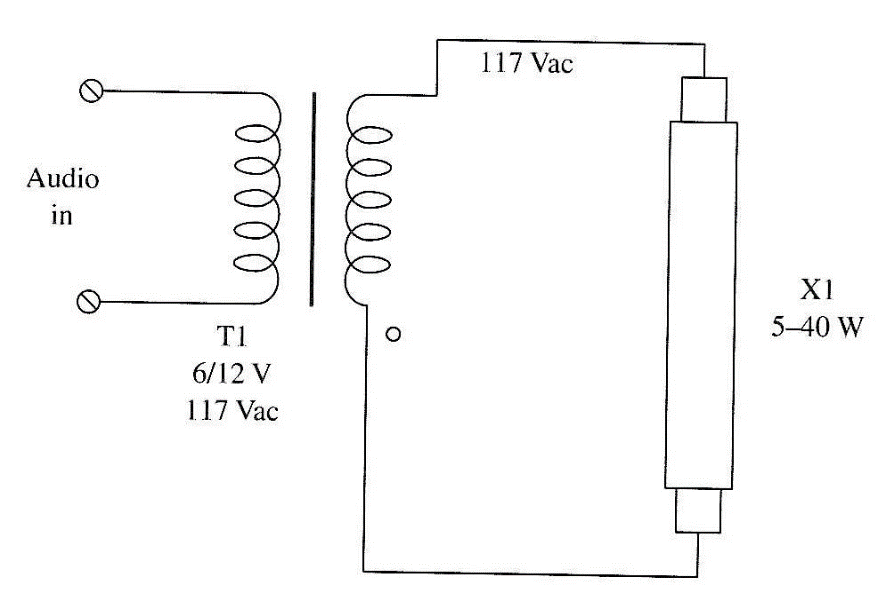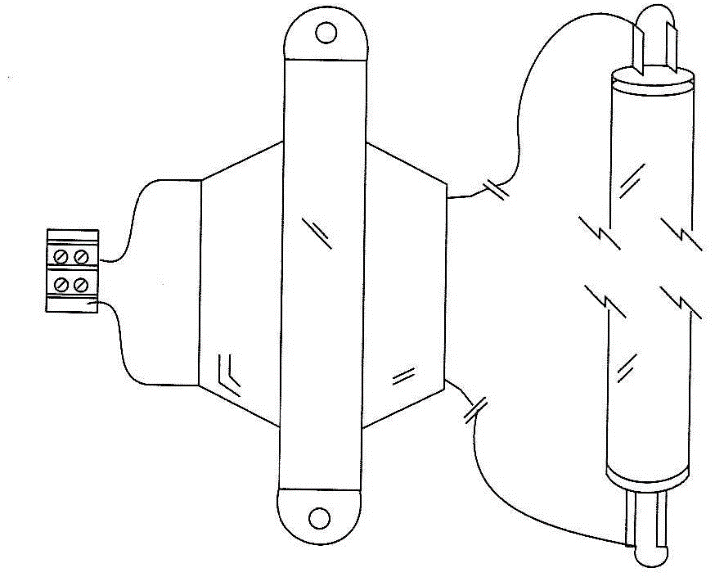How It Works
The circuit consists of a single transformer plugged into the output of any audio amplifier that has a power output in the range between 5 to 20 W. The transformer has a low-impedance winding that receives the audio signal, transforming it into a high-voltage signal. This high-voltage signal appears in the high-impedance winding where a fluorescent lamp is connected.
When applying an audio signal to the input of the amplifier, the signal is converted into high-voltage variations that make the fluorescent lamp flash at the same rate. If a white noise is used to drive the amplifier, the lamp will flash according to this source.
Even fluorescent lamps that no longer function when plugged into the ac power line can be used in this project. This is because the high-voltage spikes produced by the transformer can reach more than 400 V in some cases.
Observation
The frequency response of a fluorescent lamp is not high. Frequencies above a few kilohertz have no effect on the lamp. Because of this limitation, if you use a white noise source to modulate the lamp, the results will be less than excellent. Incandescent lamps are not recommended for this application, as their frequency response is even lower than that of a fluorescent (due to the filament inertia).
Assembly
Figure 1 is a diagram of the simple circuit. Figure 83 shows the actual appearance of the mounting. Special care must be taken in connecting the wires to the lamp. The high voltage induced by the transformer can cause severe shock if the live parts of this circuit are touched.
Any transformer with a primary winding rated from 117 to 240 V and a secondary winding rated from 9 to 12 V x 1 A or more can be used experimentally. The fluorescent lamp can be of any type with power rated to values between 5 and 40 W. Color fluorescent lamps or even ultraviolet fluorescent lamps can be used.
To plug the circuit into the output of an amplifier, use common wires with lengths up to 5 m. Long wires can cause losses in the signal, affecting the circuit performance.
Using the Circuit The circuit is plugged to the speaker output of the amplifier. The audio source, a tape recorder with a tape of noise or other sounds, can be used for this purpose. Any white noise generator, including those described in this book, can also be used as an audio source.
Adjust the volume control of the amplifier to make the lamp flicker with the sound. If the lamp doesn't flicker, even when the amp is set to maximum volume, you probably aren't using a powerful enough amplifier, or the transformer is not suitable for the task.
Do not increase the volume beyond the point where the lamp starts to flicker. Doing so may overload the transformer or the lamp, or it may saturate the circuit. If you use a powerful enough amplifier, you can drive the lamp and a loud-speaker at the same time. If you try this, be careful not to lower the impedance of the load to values below the minimum recommended. For instance, if your amplifier has a 2 ohms output, don't use a 2 ohms loudspeaker system with the lamp. Use a 4 Q system with the lamp.
Experiments
Some interesting experiments can be made with this modulated light source. You can use the lamp powered from a white noise source to illuminate a wall and take photos from it. You can also use it to illuminate the wall and use your video cam-era and VCR to record images. The lamp powered from a white noise source or other source can also be used with the light-to-sound converter.
If you drive the amplifier using a special tape of gong sounds, recorded for transcendental meditation, the lamp will follow the tones with a visual output as well as audio.
Suggestions
? Use this circuit to illuminate a wall and try to take images from it using a photographic camera or a video camera.
? Use the circuit with the light-to-sound converter. Tape sounds from an illuminated wall.
? Replace the white lamp with a color or UV (ultraviolet) fluorescent lamp. Neon lamps can also be used. (A 100 ki-2 series resistor is needed when using small neon lamps.)
? Mount two or more circuits to convert sound to light, and combine them when illuminating a wall or screen for your experiments. Plug one circuit into each output of a stereo amplifier. Use lamps of different colors for each channel.
? Appropriate sounds applied to the circuit (percussion sounds from a tape, for instance) can be used to induce sleep or to create a special mental state in transcendental meditation.
T1 Transformer, primary 6 to 12 V x 1A or 2 A (for amplifiers up to 20 W) or primary 6 to 12 V x 2 to 4 A (for amplifiers up to 100 W), secondary 117 Vac or 220/240 Vac.
X1 5 to 40 W, any fluorescent lamp (white, color, or ultraviolet) (see text) Miscellaneous Plastic box, wires, audio amplifier (5 to 100 W), etc.

